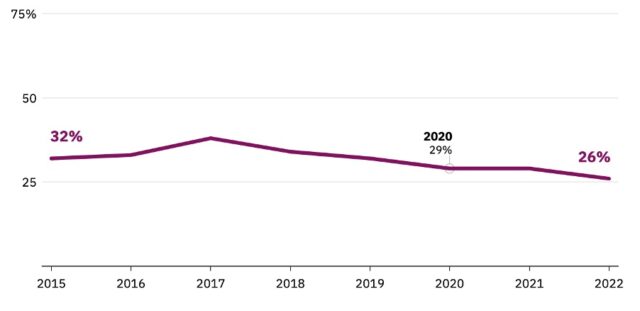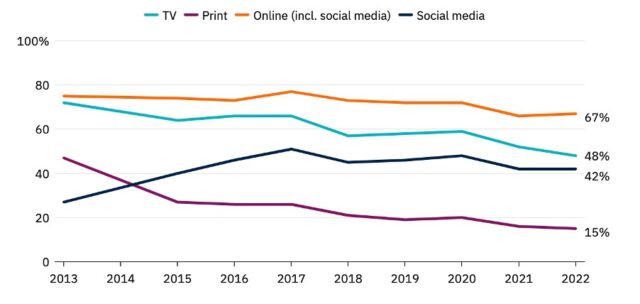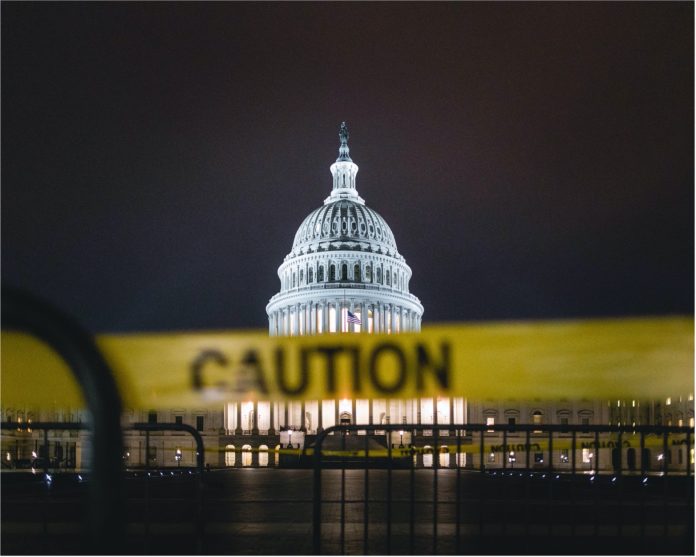The US is undergoing significant demographic, racial and societal shifts. As with other pivotal arcs of history such as the civil rights movement, it is unsurprising that heightened polarisation, structural inequalities and ruptures in democracy are eroding public trust in core institutions such as government, military, science and the media.
Essential elements of a democracy are a well-informed citizenry, active civil society, exposure to a diversity of views and trust in institutions and media. In the run-up to the US midterms, reliable and fact-driven media are an essential source of information.
Media have always been an imperfect public good, but not all media are made equal. As one of the pillars of democracy, independent media and broadsheet news play a pivotal role in transparency, accountability and informing the public. Exposure to quality news content and diverse views can fill political knowledge gaps. Yet, overall trust in the media is at an all-time low at 26% (Figure 1). Trust is strongly partisan with 93 per cent of Democrats believing the broadsheet media coverage of the 2020 US Presidential elections was fair, compared to 21 per cent of Republicans. Holding onto misperceptions is strongly associated with partisan beliefs which can compromise the space for civil democratic debate.

The current media landscape and consumption is problematic for trust. Unrecognisable from the traditional broadsheet, radio and TV 40 years ago, today’s media environment is dominated by UX and search optimisation engines, with a subsequent decline in traditional revenue sources and independent, non-partisan outlets. Traditional media broadsheets are in the unenviable position of competing with unregulated digital media content that is dominating viewer engagement as a source of information.
Ownership and commercial influence in the media are a challenge. In 2022, six conglomerates control 90 per cent of the US media environment compared to 50 companies 40 years ago. Massive layoffs of staff, such as 6,150 news workers in 2021 are common casualties of the new media system that is focusing less on local coverage. Unsurprisingly, only 18 per cent of Americans believe media are independent from political and commercial influence. The outlook isn’t all bad, however, with 8 in 10 readers sourcing news digitally. Online subscriptions to digital broadsheets such as the New York Times (8 million subscribers in 2022), The Boston Globe and LA Times have increased. Radio and podcasts are flourishing. Sources of news consumption have diversified with a strong online preference seen in Figure 2.

Digital media is a powerful tool and double-edged sword. President Barack Obama successfully leveraged voters via social media platforms in his 2008 campaign. For better or worse, digital platforms have provided frictionless and instantaneous access to information. This includes proliferation of toxic and highly contagious disinformation and misinformation such as “The Big Lie” which led to a violent attempt to overturn the 2020 election. Compounding this are user preferences and algorithms that give disproportionate influence and visibility to sensationalism and harmful content.
In a Knight-Gallop survey in 2020, four in five respondents felt they were exposed “often” to misinformation in relation to election information, with 75 percent of the misinformation source social media and 16 percent local news. In this year’s US midterm election, most Americans are aware election disinformation is a problem, with 58 per cent saying that others are susceptible, rather than themselves.
Race plays a key role in disinformation producers, who leverage division, “demographobia”, and anti-immigration rhetoric that lurk in the nation’s subconscious. A 2022 Pew Research poll found that eight in ten Black Americans reported experiencing discrimination because of their race or ethnicity. One third of Asian Americans said they had changed their daily routine due to safety concerns over racially based threats and attacks. Capitalising on fear and division is the antithesis of the Constitution, that promotes the axiom: e pluribus, unum, or “out of many one”.
In the context of a heightened polarisation, a changing racial and ethnic makeup of the electorate and fissures in views on religion, morality, class and even science, a weakened US is distracted from implementing urgently needed media reform. In the long run, it is important to understand broad structural changes and systemic issues affecting democracies. In truth, the media environment is but one part of a complex and systemic issue. So long as racial, ethnic and socio-economic fault lines remain unaddressed, trust in institutions and democracy will continue to erode.


